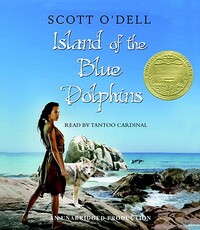You need to sign in or sign up before continuing.
Take a photo of a barcode or cover
Probably a biased review because I disliked the teaching style that was used when I went through this book in grade 7.
Super quick read and was interesting the whole way through. Perfect for younger readers... I read this so I could help my son complete his school assignment.
It’s a story about a girl who is left behind and all alone on an island... it’s about her learning to make weapons and hunt and her survival. Very well written and not overly wordy where a younger teen would easily lose interest in and yet not overly simple where an adult could get annoyed at reading. I enjoyed it, I never was bored and it’s a great story for either pre-teen boy or girl!
It’s a story about a girl who is left behind and all alone on an island... it’s about her learning to make weapons and hunt and her survival. Very well written and not overly wordy where a younger teen would easily lose interest in and yet not overly simple where an adult could get annoyed at reading. I enjoyed it, I never was bored and it’s a great story for either pre-teen boy or girl!
hopeful
informative
inspiring
sad
medium-paced
Plot or Character Driven:
Character
Strong character development:
Yes
Loveable characters:
Yes
Diverse cast of characters:
Yes
Flaws of characters a main focus:
No
I had to read this book in grade school and I remembered that I liked it but I didn't remember why. Now reading as an adult, it was so much better. So many more aspects you can understand about what she went through. It was a good book as a child it was and even better book as an adult.
challenging
hopeful
sad
fast-paced
Plot or Character Driven:
Character
Strong character development:
Yes
Loveable characters:
Yes
Diverse cast of characters:
Complicated
Flaws of characters a main focus:
Yes
I chose to reread this for the first time since I read it in middle school, and I enjoyed it as much as my first read. I am not educated enough on the topic of Native American culture to know exactly how accurate the depictions in this book are. All I will say on this part is that it seems a little off to me, and I cannot say that I believe that the way that Karana speaks is accurate to Native verbiage. I otherwise enjoy the way that she describes things- the island, the animals, their behaviors, she tells you how she feels about and sees everything. I find it slightly off-putting how in one sentence you will learn that two years have gone by, but I got used to it as I progressed. This book is very nostalgic for me so while it is not incredible from an outside perspective, that aspect of it really brings up its value to many of us who read it in childhood.
adventurous
challenging
inspiring
fast-paced
Island of the Blue Dolphins is such a beautifully written homage to our tribesmen and women, highlighting the struggles they endured during the time of colonization. Scott O'Dell paints a vivid and emotional portrait of survival, solitude, and strength. I was deeply moved by the quiet resilience of the protagonist—her tenacity in the face of grief, isolation, and the harshness of the wilderness was inspiring.
It’s both a survival story and a tribute to Indigenous courage and wisdom. A timeless tale that deserves to be remembered. Solid 4 stars from me.
It’s both a survival story and a tribute to Indigenous courage and wisdom. A timeless tale that deserves to be remembered. Solid 4 stars from me.
emotional
informative
reflective
slow-paced
To be transparent, I used to love this book as a kid. I think it was recommended to me by a teacher because I’m Native. Anyway, I went to pick it up again because I wanted to revisit it, and I found it to be deeply problematic in the way it depicted Native people. Perhaps I should have expected that from a non-Native author, but I only remembered having loved it as a child.
In the words of Debbie Reese from American Indians in Children’s Literature, “In the academic literature, Maher (1992) writes that Island of the Blue Dolphins is a “counterwestern” that gives “voice to the oppressed, to those who lost their lands and their cultures” (p. 216). Tarr (1997) disagrees with that assessment, asserting that the reader’s uncritical familiarity with stereotypical depictions of American Indians is the reason it has fared so well. Moreover, Tarr (2002) writes that the stoic characterization of Karana and her manner of speaking without contractions are stereotypical Hollywood Indian depictions rather than one that might be called authentic.”
Not only were the depictions stereotypical, they were wrong and harmful. Not only to the tribe “Karana” is a part of, but to Aleuts. Eve Tuck, am Aleut scholar writes:
“Fictionalizing an Indigenous community to make them the violent device of your plot line is a totally settler thing to do. O’Dell had no business writing a word “about” our people.
The book says nothing about us. Like Gerald Vizenor’s analysis of the figure of the ‘indian,’ it says more about the violent preoccupations of the settler, and says nothing about Unangan.
The last thing that I will say is that when I think about colonial violence that Aleut people were *actually* experiencing in their/our homelands in the time period that the book was set, it makes me doubly angry about the falsehoods depicted in this book.
But that would never be a best seller.”
For more information on the problematic nature of this book, visit here: https://americanindiansinchildrensliterature.blogspot.com/2016/06/a-critical-look-at-odells-island-of.html?m=1
In the words of Debbie Reese from American Indians in Children’s Literature, “In the academic literature, Maher (1992) writes that Island of the Blue Dolphins is a “counterwestern” that gives “voice to the oppressed, to those who lost their lands and their cultures” (p. 216). Tarr (1997) disagrees with that assessment, asserting that the reader’s uncritical familiarity with stereotypical depictions of American Indians is the reason it has fared so well. Moreover, Tarr (2002) writes that the stoic characterization of Karana and her manner of speaking without contractions are stereotypical Hollywood Indian depictions rather than one that might be called authentic.”
Not only were the depictions stereotypical, they were wrong and harmful. Not only to the tribe “Karana” is a part of, but to Aleuts. Eve Tuck, am Aleut scholar writes:
“Fictionalizing an Indigenous community to make them the violent device of your plot line is a totally settler thing to do. O’Dell had no business writing a word “about” our people.
The book says nothing about us. Like Gerald Vizenor’s analysis of the figure of the ‘indian,’ it says more about the violent preoccupations of the settler, and says nothing about Unangan.
The last thing that I will say is that when I think about colonial violence that Aleut people were *actually* experiencing in their/our homelands in the time period that the book was set, it makes me doubly angry about the falsehoods depicted in this book.
But that would never be a best seller.”
For more information on the problematic nature of this book, visit here: https://americanindiansinchildrensliterature.blogspot.com/2016/06/a-critical-look-at-odells-island-of.html?m=1
medium-paced
slow-paced






